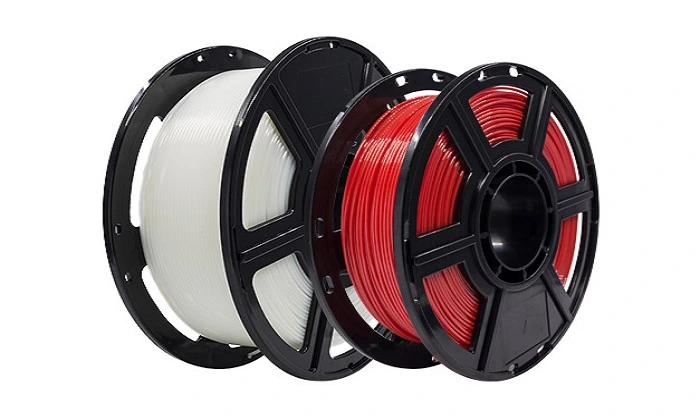3D printing materials are essential to 3D printers, like how a standard printer cannot function without printer ink. There are different types of 3D printing materials, depending on your type of 3D printer and 3d scanner.
This article will help you understand everything about 3D printing materials. You are going to understand the following concepts by reading this article wholly:
- Most popular types of 3D printers
- Different types of 3D printing materials with respect to the type of 3D printer
- How to select the ideal 3D printing materials
Let’s get right into it!
Popular Types of 3D Printers
Wax 3D Printers
In additive manufacturing, Wax printers rely on 100% wax materials for printing high-resolution wax 3D models. Since this printer can print 3D models with fine details, it is popularly used to print jewelry.
Modern 3D wax printers, such as the Flash forge WaxJet 400, can print 3D models with more than one printing material. This printing process is called multi-jet modeling, similar to how inkjet printers’ work. The printer melts the wax and extrudes the molten wax on a build platform.
The printing materials used in this process are usually the primary material together with a support material. The latter has a lower melting point than the former and is removable at the end of the process. You’ll need to heat the entire 3D model to remove the support material.
Consider this example; if you want to print a 3D dental model using wax, you can use the dental wax material together with the support material.
FDM 3D Printers
Fused Deposition Modeling (FDM) 3D printers rely on thermoplastic filaments to print high-resolution 3D models. The printer heats a thermoplastic filament to its melting point and then extrudes it using a nozzle to build your desired 3D model.
FDM 3D printers are the most widely used 3D printers because they are versatile. The printer is usable in both industrial and home settings. 3D FDM filaments are non-toxic and usable in many applications, e.g., printing toys, figurines, garage kits, etc.
It is important to note that different thermoplastic filaments have different properties, e.g., some are tougher than others. Therefore, it would be best to keenly check out the properties of a filament and compare them with your project’s requirements.
3D Resin Printers
3D resin printers rely on photosensitive liquid resin as the primary printing material. There are three main 3D resin printers:
- LCD 3D resin printers – liquid display crystal light to cure a photosensitive resin
- DLP 3D resin printers – digital light processing light to cure a photosensitive resin
- SLA 3D resin printers – UV laser beam to cure a photosensitive resin
The primary difference among these printers is their lighting source used to cure the liquid resin. All 3D resin printers produce high-resolution 3D models with fine details. 3D resin printers are popularly used in various industries, including dental, surgical guidance, jewelry, etc.
Popular 3D Printing Materials for FDM Printing
As you read earlier in this article, there are several types of 3D FDM thermoplastics. Check them out:
1. Acrylonitrile Butadiene Styrene (ABS)
Acrylonitrile Butadiene Styrene, popularly known as ABS, is one of the best 3D printing materials for FDM printing.
Considering its features, ABS 3D printing filament for 3D FDM printers is unquestionably the best material for printing functional prototypes, e.g., electronic parts.
2. Polylactic Acid (PLA)
Polylactic Acid (PLA) is, yet again, another popular 3D printing material for FDM printing. You can use it to print big 3D models.
You can use this filament in various applications, such as printing non-functional prototypes for demonstrations or even printing concept models, e.g., architectural models, etc.
3. High Impact Polystyrene (HIPS)
HIPS is widely used as a 3D printing material for FDM printing because of its lightweight material. HIPS is a popular support material for ABS and is easily dissolvable in limonene. As its name suggests, HIPS has outstanding impact resistance.
This thermoplastic material is durable, and it is also widely used as a fabrication material. It has good environmental stress crack resistance, ideal for packaging edibles, e.g., butter packaging, egg cartons, etc.
4. Polyethylene Terephthalate Glycol (PETG)
PETG 3D filament for FDM printing is water resistant and has a smooth surface finish. In addition, PETG filament is easy to print as it does not require a lot of heat compared to other filaments. After printing, a PETG model cools down efficiently without significant warpage.
However, its softness can become a liability – the finished model can have thin hairs due to stringing. Apart from that, the material is also prone to wear. It’s only logical to conclude that PETG is usable in various applications, e.g., waterproof applications to make water bottles, snap-fit applications to make battery lids, pens, etc.
5. Nylon
Nylon is a popular 3D printing material for FDM printing because it is semi-flexible and can withstand abrasion. If you want to print tough and durable models, consider using nylon 3D printing filament.
Experts may refer to nylon filament as Polyamide. This filament is ideal for printing functional prototypes and wear-resistant parts, e.g., zip ties.
6. Thermoplastic Polyurethane (TPU)
TPU 3D printing material is ideal for printing models in both consumer and industrial settings. Additionally, it is a versatile thermoplastic FDM filament for 3D printing. Its flexibility is beneficial but can become a liability depending on how you intend to use your printed 3D model.
TPU is ideal for printing prototypes that are flexible and that are resistant to both impact and abrasion. A perfect example is how it is usable in aerospace and automotive in making sensors, instrument panels, etc.
7. Composites (e.g., Fiberglass)
Composites comprise two primary components – a reinforcing material supplemented with a core polymer material. They are sought after to print 3D models that require significant rigidity or toughness.
However, this toughness can be a liability as it limits composites to a select high-end group of FDM 3D printers. Their toughness and rigidity make them usable in different industrial fields, including developing tools for aerospace, automotive, fossil fuels, etc.
Popular Resin 3D Printing Materials
1. 3D Printing Materials for LCD 3D Resin Printer
LCD 3D resin printers use three types of 3D printing materials. Check them out:
1. Standard Resin
Standard resin comes in various colors, which can be beneficial if you want to print models with different colors. It is also beneficial if you intend to color-code your 3D models. This resin is ideal for rapid prototyping and producing functional prototypes.
Standard resin is widely used in the automotive, jewelry, and even electrical industries.
2. ABS-like Resin
Unlike 3D printing materials for FDM 3D printing, ABS-like resin has properties similar to the standard ABS. It additionally offers a high-precision and smooth finish upon printing a 3D model.
This resin is primarily used in engineering as a functional prototype to make electronic and electric parts, e.g., computer fans.
3. Water-washable Resin
As its name suggests, this resin can be cleaned using water. Water-washable resin is economical because it saves money that could have been used to acquire alcohol to clean off excess resin after printing.
However, since it can dissolve in water, this resin is not usable in moist or wet environmental conditions. In addition, after washing your water-washable resin, do not pour the water into drains because it contains resin that is not safe for aquatic life.
2. 3D Printing Materials for DLP 3D Resin Printer
1. Standard DLP Printing Resin
Standard resin for DLP 3D printers is a general-purpose DLP 3D printing material. This resin usually has a gray color, is quick-curing, and does not have strong odors when printing. This resin is ideal for rapid prototyping – it has low failure and shrinkage rates and is highly stable.
2. Clear DLP Printing Resin
As its name suggests, clear DLP printing resin is transparent. Therefore, it is mainly used in applications that require transparency, e.g., surgical guidance in medicine, optics, etc. Clear DLP resin is serializable and has good biocompatibility.
3. Dental DLP Printing Resin
As its name suggests, this DLP printing resin is primarily used in printing models for dental applications, e.g., bridges, aligners, retainers, etc. This resin can also be used to print dental surgical guides.
It has low failure rates and low shrinkage with high stability.
4. Castable DLP Printing Resin
Castable resins for 3D DLP printers are popularly used in printing jewelry. The main reason for this application is that castable resins produce high-resolution models with fine details. In addition, the final piece has smooth surfaces.
This resin does not have strong odors and does not harm your health.
Popular Wax 3D Printing Materials
Wax 3D printing materials are made from 100% wax. They are light and eco-friendly compared to plastic filaments. As such, wax 3D printing materials are more expensive than plastic filaments.
Wax 3D printing materials are primarily used in creating dental and jewelry models. This material offers you high-resolution models with a smooth surface. You can also use wax materials to print aerospace and dental models.
One of the advantages of using wax 3D printing materials is that they do not have ash content.
Final Thoughts
3D printing materials are essential to 3D printers. In addition, 3D printing is continually gaining popularity in different industries. However, selecting the ideal 3D printing material can be an intimidating process.
Follow the recommendations outlined in this article to get your ideal 3D printing material. Doing so will enable you to have high-resolution 3D models efficiently.







